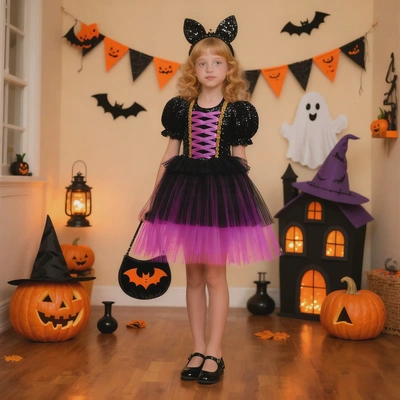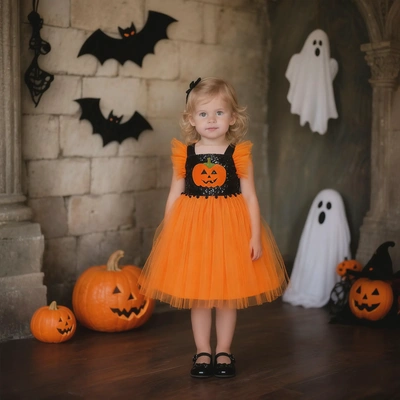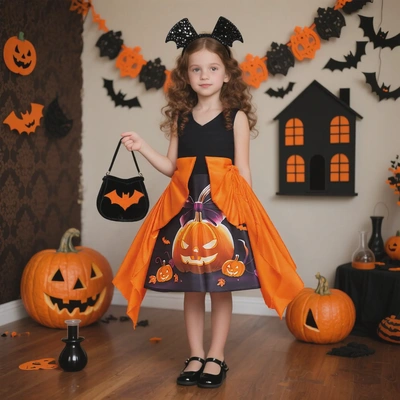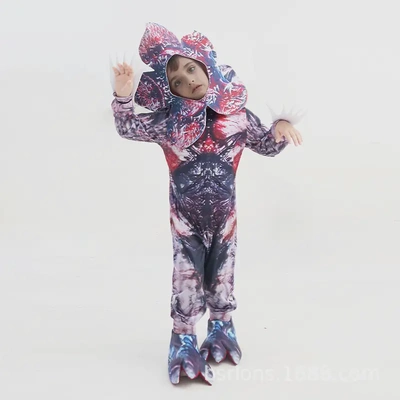How to Choose a Comfortable Halloween children's performance costume in the UK?
Introduction
Halloween is a time of fun and creativity for children in the UK, especially when it comes to performances. Selecting a comfortable costume is crucial to ensure they can fully enjoy the experience without any distractions. Here are some key aspects to consider when making your choice.

1. Consider the Fabric
1.1 Breathability
- Natural Fibers: Opt for costumes made from natural fibers such as cotton. Cotton is highly breathable, allowing air to circulate the child's body. This is important as children can get quite active during Halloween performances, and breathable fabric helps prevent sweating and discomfort. For example, a cotton-based witch's dress or a pirate's shirt will keep the child cool and comfortable.
- Avoid Synthetic Fabrics: Synthetic fabrics like polyester may not be as breathable. While they can sometimes be more durable and have a shiny appearance, they can trap heat and moisture, making the child feel hot and sticky. However, if you do choose a costume with some synthetic elements, look for those with ventilation features such as mesh panels or breathable linings.
1.2 Softness
- Gentle on the Skin: Children have sensitive skin, so the fabric of the costume should be soft. Rubbing or irritation from rough fabric can quickly turn a fun experience into an unpleasant one. Feel the fabric before purchasing to ensure it has a smooth texture. Fleece is a great option for softness, often used in costumes like teddy bear or sheep outfits, providing a cozy and gentle feel against the skin.
- Lining Considerations: If the costume has a lining, make sure it is also soft. A scratchy lining can be just as uncomfortable as a rough outer fabric. Look for costumes with cotton or satin linings, which are known for their softness.
2. Ensure a Proper Fit
2.1 Measure Your Child
- Accurate Measurements: Take accurate measurements of your child's chest, waist, hips, and height. Use a flexible measuring tape and measure over light clothing. Different costume styles may fit differently, so having these measurements on hand will help you choose the right size. For instance, a superhero costume with a form - fitting bodysuit will require precise chest and waist measurements to ensure a comfortable fit.
- Check Size Charts: Most costume manufacturers provide size charts. Compare your child's measurements with the chart provided by the brand. Keep in mind that size charts can vary between manufacturers, so don't rely solely on the general age-based sizing. For example, a size labeled as “age 6 - 8” from one brand may not be the same as another brand's equivalent size.
2.2 Allow for Movement
- Loose-Fitting Options: Choose a costume that allows for a full range of movement. A tight-fitting costume can restrict the child's ability to run, jump, or dance during the performance. A loose-fitting ghost costume or a flowing fairy dress will give the child the freedom to move around easily. However, be careful not to choose a costume that is too loose, as it may trip the child.
- Stretchy Fabrics: Costumes made from stretchy fabrics can be a great choice. Fabrics like spandex or elastane can stretch to accommodate the child's movements while still maintaining the shape of the costume. This is especially beneficial for costumes like superhero or ninja outfits, where the child may need to make quick, energetic movements.
3. Evaluate the Design
3.1 Simple and Practical Design
- Avoid Over-Complicated Costumes: Over-complicated costumes with too many layers, heavy accessories, or complex fastenings can be uncomfortable for children. For example, a costume with multiple layers of heavy tulle or a suit of armor-like costume with lots of metal-like accents may be difficult for a child to move in. Instead, opt for a simple yet effective design that still captures the Halloween spirit.
- Easy - to - Use Fastenings: Check the fastenings on the costume. Zippers should be smooth and easy to operate, and buttons should be securely attached. Velcro fastenings can also be a good option as they are quick and easy for children to use. Avoid costumes with small or hard - to - reach fastenings, as these can cause frustration for the child and may even pose a choking hazard if the fastenings come loose.
3.2 Safety Features
- Flame - Retardant Fabrics: In the UK, it's important to ensure that the costume is made from flame - retardant fabric, especially if there will be any candles or other heat sources at the Halloween event. This helps protect the child in case of an accidental fire. Look for labels indicating that the costume meets the relevant safety standards for flame - retardancy.
- Secure Accessories: If the costume comes with accessories such as hats, masks, or capes, make sure they are securely attached. Loose accessories can fall off during the performance or, in the case of masks, may obstruct the child's vision if not properly fitted. For example, a mask should have adjustable straps to ensure a secure and comfortable fit without covering the eyes.
4. Consider the Weather
4.1 Cold Weather Considerations
- Layering Options: If Halloween in the UK is likely to be cold, choose a costume that allows for layering. A base layer of thermal underwear can be worn under the costume to keep the child warm. For example, a vampire costume can be paired with thermal tights and a long-sleeved top underneath. Additionally, look for costumes made from thicker fabrics or with insulated linings.
- Footwear and Headgear: Don't forget about footwear and headgear. A warm hat and comfortable, closed-toe shoes are essential. For a winter-themed Halloween costume, boots can add to the look while keeping the feet warm. A knitted hat can be incorporated into the costume, like a beanie for a snowman costume.
4.2 Warm Weather Considerations
- Lightweight Fabrics: In case of warmer weather, lightweight fabrics are key. Linen or lightweight cotton costumes will keep the child cool. For example, a lightweight mummy costume made from linen strips can be both breathable and in-theme. Avoid heavy, thick fabrics that can cause the child to overheat.
- Ventilation Features: Look for costumes with ventilation features such as cut-out sections, mesh panels, or open-back designs. These can help air circulate in the body, making the child more comfortable in warmer temperatures. A pirate costume with a mesh-lined vest, for instance, can provide ventilation.
5. FAQ
Q: What if my child has a skin allergy?
A: If your child has a skin allergy, look for hypoallergenic fabrics. Organic cotton is a great option as it is grown without pesticides and is less likely to cause allergic reactions. Also, avoid costumes with synthetic dyes or strong chemicals. Check the product label for information on fabric composition and any potential allergens. If possible, let your child try on the costume for a short period to see if there is any adverse reaction.
Q: Can I alter a purchased costume for a better fit?
A: Yes, you can. If the costume is slightly too big or too small, you can make some simple alterations. For a too-big costume, you can use a sewing machine or fabric glue to take in the seams. If it's too small, you can add fabric panels to increase the size. However, be careful not to damage any details or features of the costume. If you're not confident in your sewing skills, you can take the costume to a professional tailor.
6. Conclusion
Choosing a comfortable Halloween children's performance costume in the UK involves considering fabric, fit, design, and the weather. By taking these factors into account, you can ensure that your child has a great time during their Halloween performance, free from discomfort and distractions.





